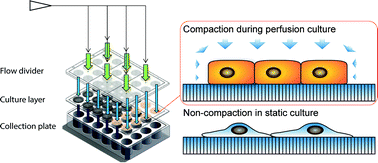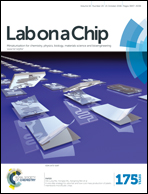A vertical-flow bioreactor array compacts hepatocytes for enhanced polarity and functions†
Abstract
Although hepatocytes in vivo experience intra-abdominal pressure (IAP), pressure is typically not incorporated in hepatocyte culture systems. The cuboidal cell shape and extent of intercellular contact between cultured hepatocytes are critical parameters that influence the differentiated hepatic phenotype. Using a microfluidic device, the application of pressure to artificially compact cells and forge cell–cell interactions was previously demonstrated to be effective in accelerating hepatic repolarization. In seeking to implement this approach to higher throughput culture platforms for potential drug screening applications, we specifically designed a vertical-flow compaction bioreactor array (VCBA) that compacts hepatocytes within the range of IAP and portal pressure in vivo in a multi-well setup. As a result of vertical perfusion-generated forces, hepatocytes not only exhibited accelerated repolarization, an in vivo-like cuboidal morphology, but also better maintained hepatic functions in long-term culture as compared to the same cells cultured under static conditions. As a novel engineering tool to modulate cell compaction and intercellular interactions, this platform is a promising approach to confer tight control over hepatocyte repolarization for in vitro culture.



 Please wait while we load your content...
Please wait while we load your content...